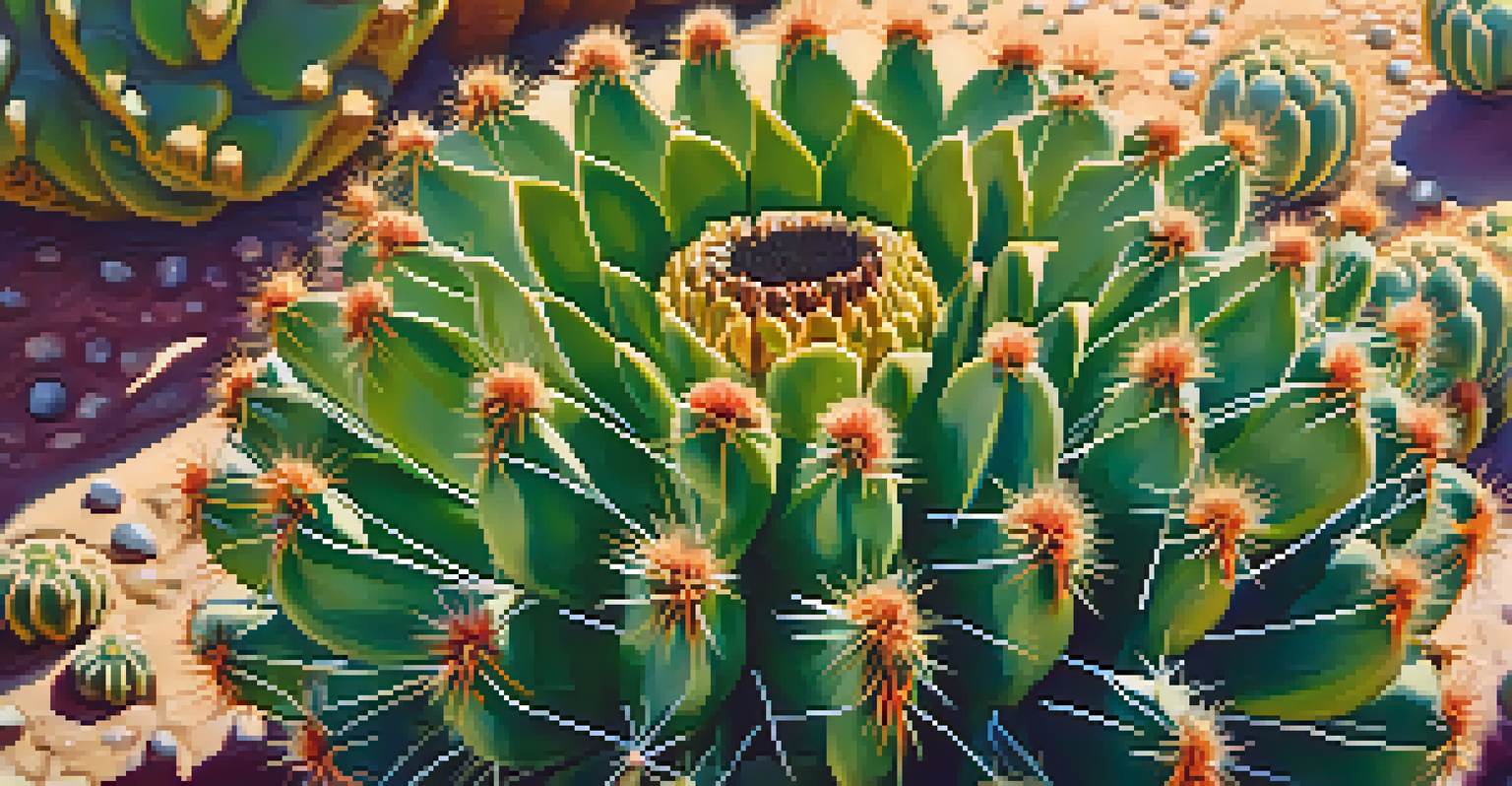Peyote's Role in Healing: Indigenous Practices vs. Modernity

Understanding Peyote: A Sacred Cactus
Peyote, a small cactus native to Mexico and the southwestern United States, has been used for centuries by Indigenous peoples in spiritual and healing rituals. Its psychoactive compound, mescaline, is known to induce profound altered states of consciousness. For many, Peyote is not just a plant; it embodies a connection to their ancestors and cultural identity. This sacred relationship is crucial in understanding how Peyote is integrated into both traditional and contemporary healing practices.
The plants and the animals are our brothers and sisters. They are part of us. We are all connected.
In Indigenous cultures, Peyote is often consumed during ceremonies that aim to heal the mind, body, and spirit. These rituals can involve music, prayer, and group sharing, creating a supportive environment for emotional and spiritual healing. This communal aspect fosters a sense of belonging and connection, reinforcing the belief that healing is not just an individual journey but a collective one. Such practices highlight the holistic approach of Indigenous healing traditions.
While modern society often views healing through a clinical lens, the Indigenous perspective emphasizes the importance of spirituality and community. The use of Peyote in these contexts serves as a reminder of the interconnectedness of all aspects of well-being. As we explore Peyote's role in healing, it's essential to appreciate this rich cultural heritage that has shaped its significance over generations.
Indigenous Healing Practices with Peyote
Indigenous healing practices surrounding Peyote are deeply rooted in history and spirituality. These ceremonies often involve a Peyote ceremony leader, who guides participants through the experience, ensuring a safe and meaningful journey. The process usually includes consuming Peyote under the guidance of experienced practitioners, allowing individuals to explore their inner worlds and confront personal challenges. This setting fosters a sense of safety and community, crucial for effective healing.

During these ceremonies, participants often report profound insights, emotional releases, and a heightened sense of connection to nature and each other. The shared experience can lead to collective healing and stronger community bonds, as stories and experiences are exchanged. This aspect of communal support is a vital part of Indigenous practices, creating a nurturing environment for healing and personal growth.
Peyote's Cultural Significance
Peyote is not merely a plant; it represents a profound connection to cultural identity and heritage for Indigenous peoples.
Moreover, these traditional healing practices are not just about the individual; they emphasize the importance of balance and harmony within the community. The use of Peyote is seen as a way to restore this balance, addressing not only personal afflictions but also communal issues. By integrating spirituality, culture, and community, Indigenous healing practices with Peyote offer a comprehensive approach to well-being.
Modern Perspectives on Peyote and Healing
In recent years, there has been a growing interest in the therapeutic potential of Peyote and other psychedelics in modern medicine. Researchers are exploring how compounds like mescaline can aid in treating mental health disorders such as PTSD, depression, and anxiety. This renewed focus on psychedelics aligns with a broader movement toward holistic and integrative health approaches, where mind, body, and spirit are considered interconnected.
The greatest healing therapy is friendship and love.
Modern studies have begun to substantiate some of the healing claims made by Indigenous practitioners. For example, clinical research highlights how guided psychedelic experiences can facilitate emotional breakthroughs and enhance psychological resilience. However, it's crucial to navigate this interest respectfully, recognizing the cultural significance of Peyote and the need for appropriate contexts in which to use it.
Furthermore, the dialogue between Indigenous practices and modern science presents an opportunity for mutual learning. While modern medicine often prioritizes individual treatment, Indigenous practices emphasize community and spirituality. By finding common ground, we can enhance our understanding of healing and potentially integrate the best of both worlds for holistic well-being.
Challenges of Cultural Appropriation in Peyote Use
As modern interest in Peyote grows, so does the risk of cultural appropriation. This term refers to the inappropriate adoption of elements from one culture by members of another, often without understanding or respect for its significance. In the case of Peyote, there is a danger that individuals outside Indigenous communities may use it casually, reducing its sacredness and undermining its cultural roots.
Cultural appropriation not only disrespects Indigenous traditions but can also lead to harmful consequences for communities that have relied on Peyote for healing. This includes the commodification of Peyote as a recreational substance rather than a sacred plant used in serious spiritual practices. Such actions can dilute the cultural narratives and practices that have sustained Indigenous peoples for generations.
Healing Through Community Rituals
Indigenous healing practices using Peyote emphasize communal support and spiritual connection, highlighting the importance of collective well-being.
To combat these challenges, it's essential to advocate for respectful engagement with Indigenous practices. This involves listening to Indigenous voices, supporting their rights to their cultural heritage, and understanding the context in which Peyote should be used. By honoring these traditions, we can help preserve their significance while promoting a responsible approach to healing.
Legal Status of Peyote: Navigating the Landscape
The legal status of Peyote varies widely across different regions, particularly in the United States. While some Indigenous tribes are allowed to use Peyote in religious ceremonies under the American Indian Religious Freedom Act, its use remains illegal for non-Indigenous people. This creates a complex landscape where the sacred practice is protected for some while being inaccessible for others, leading to ongoing debates about legality and cultural rights.
In contrast, other psychedelics are gaining traction in the realm of modern medicine, with some jurisdictions moving toward legalization for therapeutic use. This discrepancy raises questions about fairness and respect for Indigenous practices. The legal framework surrounding Peyote must consider the cultural significance it holds for Indigenous communities while also addressing the growing interest in its therapeutic potential among the wider population.
As we navigate these legal complexities, it's crucial to advocate for policies that respect Indigenous rights while promoting responsible research and use of Peyote. Engaging in dialogue with Indigenous leaders can help bridge the gap between modern medicine and traditional practices, ensuring that both perspectives are honored in the evolving conversation around Peyote and healing.
The Future of Peyote in Healing Practices
Looking ahead, the future of Peyote in healing practices will likely be shaped by a blend of Indigenous wisdom and modern scientific inquiry. As interest in psychedelics continues to grow, there is potential for meaningful collaborations that honor the rich traditions of Indigenous peoples while exploring the therapeutic possibilities of Peyote. These partnerships could lead to a more comprehensive understanding of healing that respects cultural heritage.
Moreover, education will play a vital role in shaping perceptions around Peyote and its use. By raising awareness about the historical and cultural significance of Peyote, we can foster a deeper appreciation for its role in Indigenous healing practices. This understanding can help combat cultural appropriation and promote respectful engagement with these traditions.
Navigating Cultural Appropriation
As interest in Peyote grows, respecting its cultural roots and advocating for Indigenous rights is essential to prevent cultural appropriation.
Ultimately, the journey of Peyote as a healing agent will require ongoing dialogue and collaboration between Indigenous communities and modern practitioners. By honoring the past while embracing the future, we can create a more inclusive approach to healing that benefits everyone.
Conclusion: Bridging Traditions and Modern Practices
In conclusion, Peyote serves as a powerful symbol of healing that bridges Indigenous practices and modern therapeutic approaches. By understanding its significance within Indigenous cultures, we can appreciate the depth and complexity of its use. The respectful integration of Peyote into modern healing practices has the potential to enrich our understanding of mental health and well-being.
As we continue to explore Peyote's role in healing, it's essential to prioritize respect for Indigenous knowledge and traditions. Engaging in meaningful conversations, advocating for Indigenous rights, and promoting ethical practices will be crucial in navigating the future of Peyote in healing. This partnership can lead to a richer, more holistic approach to health that benefits both Indigenous and non-Indigenous communities.

Ultimately, Peyote's journey reminds us of the importance of honoring our roots while embracing new possibilities. By bridging these traditions with modern practices, we can pave the way for a more inclusive and compassionate understanding of healing that respects all paths to wellness.